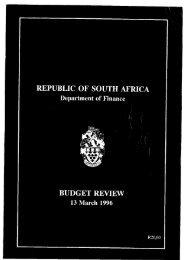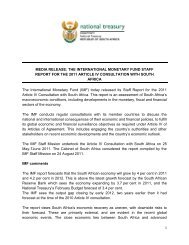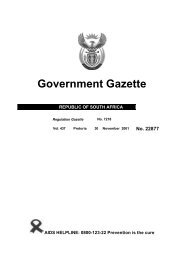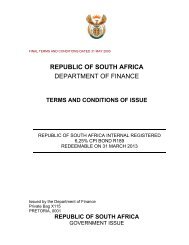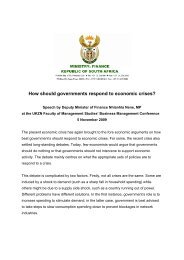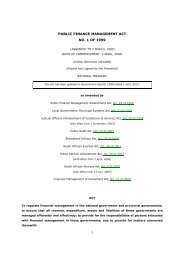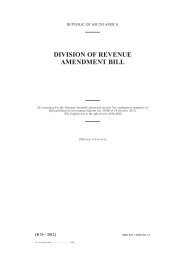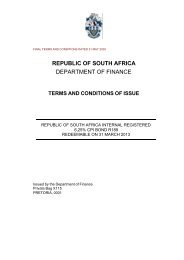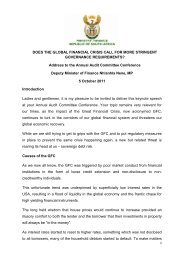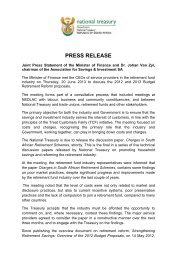1998 SOUTHERN AFRICA ECONOMIC ... - National Treasury
1998 SOUTHERN AFRICA ECONOMIC ... - National Treasury
1998 SOUTHERN AFRICA ECONOMIC ... - National Treasury
You also want an ePaper? Increase the reach of your titles
YUMPU automatically turns print PDFs into web optimized ePapers that Google loves.
N A M I B I A<br />
and wharf facilities. It is expected that the volume of cargo<br />
passing through Namibia will increase with the re c e n t<br />
completion of the Trans-Kalahari or “Coast-to-Coast” transport<br />
c o rr i d o r, linking Namibia with the South African industrial<br />
p rovince Gauteng. F u rther upgrading is to be done to incre a s e<br />
the current capacity of 2m tons of freight to up to 5m tons.<br />
Air Namibia operates domestic, regional (Ango l a , B o t sw a n a ,<br />
South A f r i c a ,Z a m b i a ,Z i m b a b we) and international (Frankfurt,<br />
London) scheduled passenger and freight serv i c e s . O t h e r<br />
airlines flying to Windhoek include South African A i r w ay s ,A i r<br />
Z i m b a b we,Air Botsw a n a ,A n golan A i r l i n e s ,C o m a i r, SA Expre s s ,<br />
and Lufthansa. Namibia has 28 licensed and some 300<br />
unlicensed aero d romes and airstrips.<br />
The mobile telephone network which covers the country ’s main<br />
10-15 centres is curre n t ly undergoing rapid expansion. T h e<br />
i n d u s t ry offers considerable possibilities for further upgrading.<br />
Namibia Te l e kom was re c e n t ly transformed into a commerc i a l<br />
o p e r a t i o n .<br />
E C O N O M I C O V E R V I E W<br />
I n t ro d u c t i o n<br />
At independence in 1990 the new ly elected government faced<br />
the challenge of add ressing economic imbalances and<br />
reactivating growth after a decade of virtual stagnation. It opted<br />
for a strategy designed to gain the confidence of fo reign and<br />
domestic inve s t o r s , n a m e ly broadening of manu f a c t u r i n g<br />
activities and tourism, i n c reased value-adding of domestic raw<br />
materials for export , and expanding skills through investment in<br />
training and education. Details of the strategy are set out in<br />
N a m i b i a ’s first five - year plan covering 1995/96 - 1999/2000.<br />
Recent Macro-Economic Deve l o p m e n t s<br />
Available data suggest that the real economic growth in 1997<br />
d e c reased somewhat from 6.5 percent in 1996 to 4.1 perc e n t .<br />
N a m i b i a ’s economic performance is influenced to a great extent<br />
by weather and oceanic conditions, as well as international<br />
commodity marke t s . Real output benefited from stro n g<br />
external demand for mining and fish export s , as well as the<br />
d e p reciation of the Namibian dollar.Agricultural activities we re<br />
a f fected by the restocking of livestock fo l l owing the dro u g h t .<br />
I n c rease in the interest rates impacted adve r s e ly on the re t a i l<br />
trade and construction, and subsequently led to a decline in<br />
consumption cre d i t .<br />
During the first half of 1997 international re s e rves declined in<br />
response to increase in government expenditure. T h e<br />
government there fo re had to introduce measures poised<br />
t ow a rds reducing expenditure as well as raising add i t i o n a l<br />
reve nu e. Public debt which has been on a declining trend since<br />
1990 was reduced to 21.2 percent of GDP in 1997 reflecting the<br />
writing off of the pre-independence loan by the South A f r i c a n<br />
G ove r n m e n t .<br />
The rate of growth in monetary aggre g a t e s ,which accelerated<br />
in the first half of 1997, s h owed signs of abatement in the second<br />
half of the ye a r.At the end of the ye a r, m o n ey supply incre a s e d<br />
by 7.6 percent compared to 24.3 percent in 1996. A c c o u n t i n g<br />
for growth in money supply in the first half of 1997 was a faster<br />
g rowth in net credit to the government and a substantial<br />
i n c rease in net fo reign assets of the banking system.<br />
The trend in money market rates since the end of 1996 was<br />
g re a t ly influenced by expectations of a dow n w a rd adjustment in<br />
the South African Bank rate. The rates rose sharply betwe e n<br />
N ovember 1996 and Janu a ry 1997, but thereafter declined<br />
t h roughout the ye a r.<br />
Declining consumption expenditure and import prices during<br />
the last two years have contributed in putting a dow n w a rd<br />
p re s s u re on domestic inflation, p a rt i c u l a r ly during the second<br />
half of 1997. Rising labour costs, we a ker rand and rising fo o d<br />
prices in South Africa accelerated the rate of inflation import e d<br />
into Namibia during the second half of 1996, when the ave r a g e<br />
rates rose to 8.2 perc e n t .In fact the rate of inflation has been<br />
falling steadily reaching the lowest year on year rate eve r<br />
re c o rded of 6.9 percent in December 1997.<br />
The current account of the balance of payment re g i s t e red a<br />
surplus in 1997.This was brought about by a combination of a<br />
decline in domestic expenditure, reduced growth in import s ,a s<br />
well as an increase in the value of merchandise export s .C ap i t a l<br />
and financial account re g i s t e red the largest deficit since 1990,<br />
h owever the surplus on the current account led to a rise in<br />
international re s e rves of NAD312m (USD 68m) compared with<br />
an increase of only NAD98m (USD23m) in the previous ye a r.<br />
The Namibian dollar is fixed on one-to-one basis with the South<br />
African rand, t h e re fo re the development of the South A f r i c a<br />
rand affects the Namibian dollar dire c t ly. In 1996 the Namibian<br />
dollar depreciated by 21.9 percent to an average of NAD4.30<br />
against the USD. In 1997 the Namibian dollar declined by 6.7<br />
p e rcent and reached an average of NAD4.61 against the USD.<br />
The Namibian dollar strengthened against the German mark in<br />
the first three quarters of 1997 but depreciated sharply in the<br />
last quart e r. Against the British pound, the Namibian dollar<br />
gained strength in the first half of the year but depreciated on<br />
account of quick growth in the UK economy.<br />
Financial Institutions<br />
The functions of central banking we re prev i o u s ly handled by the<br />
R e s e rve Bank of South A f r i c a ,and we re transfe rred to the Bank<br />
of Namibia in 1990. The Bank became fully operative after<br />
i n t roducing Namibia’s own currency in September 1993.<br />
Six commercial banks dominate the economy, the largest being<br />
First <strong>National</strong> Bank of Namibia and Standard Bank Namibia.<br />
Other financial institutions include building societies, i n s u r a n c e<br />
companies and public finance institutions, including the<br />
D evelopment Fund of Namibia and the Agricultural Bank of<br />
N a m i b i a . All banks provide compre h e n s i ve domestic and<br />
international serv i c e s . S h o rt-term insurance and life insurance<br />
b ro k i n g ,estate planning and factoring are some of the ancillary<br />
s e rvices provided by the banking sector.<br />
The central bank, the Ministry of Finance and the private<br />
financial sector are active ly pursuing the establishment of<br />
financial instruments and marke t s , such as parastatal bills,<br />
d e b e n t u res and bonds,government tre a s u ry bills and nego t i a b l e<br />
c e rtificates of deposit. A c c o m p a nying this also is the rap i d<br />
d evelopment of a domestic money market and fo reign exchange<br />
m a r ke t .Local interbank lending is limited due to the size of the<br />
m a r ke t ,and local banks are often re fe rred to the South A f r i c a n<br />
interbank marke t .<br />
Namibia Stock Exchange<br />
The Namibia Stock Exchange (NSE) began operating in October<br />
1992 . The stock exchange is a non-profit organization of listed<br />
c o m p a n i e s ,h oweve r.To date the number of companies listed has<br />
risen to 33, constituting a market capitalisation of about<br />
USD31,804.3 m. The increase in the number of listed<br />
c o m p a n i e s ,p a rt i c u l a r ly from 1995 has been due to grow i n g<br />
p a rticipation by fo reign inve s t o r s , which also should have<br />
boosted market liquidity. A new scre e n - b a s e d - c o m p u t e r- t r a d i n g<br />
s y s t e m , based on price-time priority dealing rules on a<br />
c o n t i nuous basis,has been developed by the NSE. Settlement is,<br />
h oweve r, still operated manu a l ly. E f fo rts are afoot for finalising<br />
the introduction of a central depository system.<br />
65



